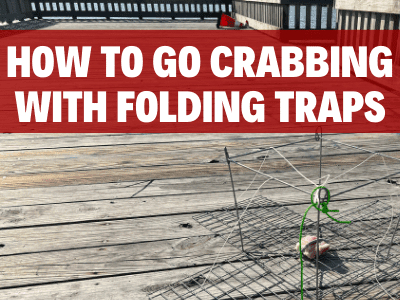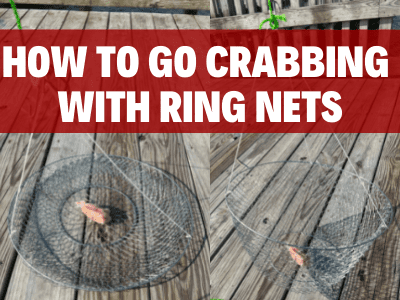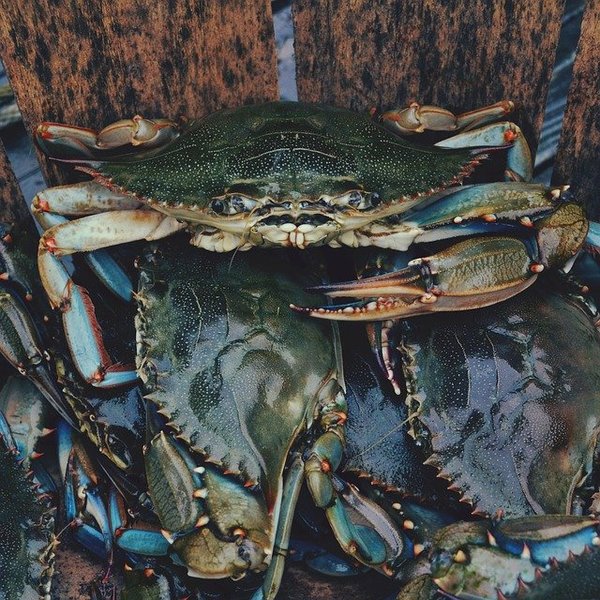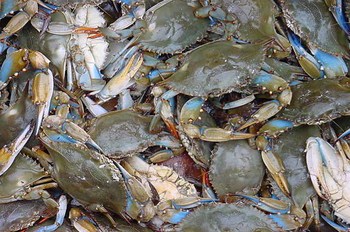Crabbing with Hand Lines: The Quick & Easy Guide
Also known as chicken necking or crabbing with string, hand lines are the perfect way to spend a day crabbing.
You don’t truly enjoy the sport until you catch a blue crab with some string and a chicken neck. Not only is it enjoyable for crabbers of all ages, but it’s also easy to learn and will keep you entertained for hours on end.
However, it takes a bit of technique and practice to get it right. Let’s go over how to go crabbing with hand lines.
Getting Started in 3 Easy Steps
Step 1: Know Your State’s Crabbing Regulations
Before you even think of heading to the water, the first thing you should do is check your state’s crabbing regulations.
Most often crabbing with a string does not require a recreational license of any sort. There are sometimes small restrictions that limit how many hand lines you can use, set a minimum crab size, and so forth.
It’s important to know and understand your state’s laws. You don’t want to land any hefty fines over a simple crabbing trip.
You can do so by searching on Google: “(state) crabbing regulations”.
If that doesn’t work, look up: “(your state) DNR”. This will take you to your state’s Department of Natural Resources Website where you’ll be sure to find plenty of relevant information.
Step 2: Come Prepared
My favorite part of chicken necking is how inexpensive and simple it is. You only need just a few things to be successful.
When crabbing with hand lines you will need weighted hand lines or plenty of cotton string, some bait, and a dip net.
The chose is yours whether you want to buy a pre-made handline or use string. I recommend using weighted lines if the water is rough or the current is strong so that your line doesn’t float away. I believe it’s worth the buy based solely on how inexpensive they are.
The ideal bait for hand lines is chicken necks. They are tough, long lasting, and easy to tie a string around. An alternative would be chicken drumsticks; they’re a bit cheaper.
You can experiment with other baits, such as fish or squid, as you please. This is especially easy if you purchase a pre-made weighted line and clip. Simply stab your bait with the clip at the end of your line as you would a worm on a fishing hook.
Along with the essentials, I suggest bringing:
- A bucket or cooler for carrying your catch
- A crab guage to make sure your crabs are keepers
- A fishing rod or good book to pass the time
Step 3: Find The Right Crabbing Spot
You have everything you need, know the rules, and have a good idea of how to use a hand line. Now you just a spot to go crabbing.
Blue crabs live in salty, brackish bodies of water. We’re using a crabbing method that works best along calm shorelines just a few feet deep.
Any public spots with calm shorelines that permit crabbing or fishing would do just fine. Public and State parks are great choices.
Hand lines are so versatile that any shoreline with easy access to shallow water with crabs will do just fine.
One thing to look for in choosing your spot is a flat, sandy bottom and shoreline. This will make crabbing much easier so that you won’t run into any rocks while pulling in your lines.
The Technique
Start with a piece of string. Crab’s don’t pull that hard, so it does not have to be very durable. Fishing line, paracord, or cotton string would do just fine. You want enough to reach far enough out in the water, so I’d say about 10 feet or so.
On one end of your line tie some smelly bait. I recommend chicken necks because of how easy they are to tie.
You will also need to tie some weight to your line, depending on the strength of the current. Your bait needs to sink to the bottom for this to work.
Quick Tip: You can buy pre-made hand lines on Amazon.
The concept is very simple. Use bait to lure crabs with its stinky scent, slowly draw them closer, then scoop ‘em up!
Let’s break it down. Start by casting your weight and bait about 8 feet out into the water where it’s 2-3 feet deep. Tie the other end to a stick or branch, while leaving some slack in the line.
Now, we wait. After 10 to 15 minutes or so, you should see the line start to tighten or go really limp. That means there’s a crab trying to get away with your bait! Now’s your time.
To make sure there’s actually a crab on your line, pick it up and pull a tiny bit. If you feel small bumps and vibrations, there’s a crab feasting on your bait.
Have a friend ready the dip net, while you very slowly pull the string closer and closer to shore. You’ll want to do this in a slow, hand over hand technique. Grab inches at a time. The trick is to stay patient. Once it gets close enough, you should be able to see the crab nibbling away at your chicken.
That’s when you, or your friend, scoop the crab up from behind with your dip net. You need to be quick, they’re surprisingly fast swimmers.
If all goes well, you should have a crab! Measure it to make sure it’s of legal size, then toss it in a bucket or cooler.
Congratulations! You just caught a blue crab with only some chicken and string.
This is not only a fun way to catch some crab dinner, but this can also come in handy in a survival situation. You can easily substitute chicken for dead animal meat and string for plant fibers and easily catch a crab dinner in the wild. That would be an interesting Youtube video…
Useful Tips & Tricks
Be sure to bookmark this page. I’ll be adding more tips as I learn.
1) Utilizing PVC Pipes
Let’s say your shoreline isn’t the greatest. Don’t let a bunch of rocks and lack of areas to tie your line to get in the way of your crabbing trip.
You can easily bring a PVC pipe and simply stick it in the dirt or sand vertically. This will give you a point to tie one or two hand lines to, and you can use it as a holder for your dip net.
You can also stick it in the ground horizontally if the shoreline is too steep. This will give you a farther reach out into the water for a more sandy bottom past any rocky edges.
If the water is shallow enough and you want to cover more ground, PVC pipes are just the thing. You can wade out 20ft or so into the water and stick your PVC pipe in the sand vertically. Let 5 feet or so stick out of the water.
From there you can tie 4 hand lines and throw them out from the pole. You’ll be able to cover more ground, which gives you a better chance of catching some tasty blue crabs.
2) Make Use of Nature
A solid stick or small branch can come in handy while crabbing with hand lines.
If you’re on a beach that doesn’t have anywhere to tie your hand lines, a stick will do just fine.
Tie a square knot in the center and stab one end in the sand, leaving some slack.
When the string becomes taught, you can use the stick to help make sure the crab never notices. If you slowly wind in the string with the stick, the crab will be none the wiser! He’ll keep eating your bait without a care in the world.
This makes catching him with your dip net much easier. Simply pull him close to shore and scoop him up. He would have gotten there so slowly he would never see it coming. Just be sure to be quick with the net.
Related Questions
I took my best guess on what you would ask next. If you have any other questions, leave a comment and I’ll get back to you as soon as I can.
When’s the best time to go crabbing?
Most agree that the best time to go crabbing is during slack tide, the tide just after high or low tide. That is when the water is moving the fastest, making the crabs most active.
How do I keep crabs alive?
Any well-insulated cooler does wonders keeping crabs alive. Keep the cooler out of direct sunlight and free of standing water. They will last up to 24 hours if they are kept cool and moist.
Should I clean my crabs before cooking?
This is totally up to personal preference. If you aren’t a fan of the crab guts and mustard, clean your crabs before you cook them. For a visualization on cleaning crabs, check our Deermeatfordinner’s crabbing video above.






